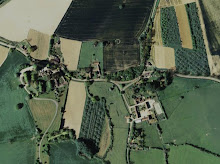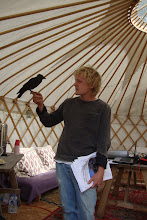
Today I braved some fairly angry rain storms to visit a big pear orchard in Conderton (near Tewksbury), Worcestershire. At several hectares in size, several hundered trees and over a century old, there's an awful lot to try and condense into a few photos. It is certainly one of the best orchards I have yet visited and perfectly illustrates the similarity of old traditional orchards to
woodland pasture. Indeed, because of it's size and scale I don't expect there are many in the whole county to rival it, especially in terms of habitat diversity and potential for biodiversity. It is begging out for a full species inventory to be undertaken.

That hole was perfect for a
Little owl and they love orchards like this one. This is also one of the first orchards I have documented that have had abundant
mistletoe (Viscum album) in them. It just doesn't seem to be as common around Charingworth. Misletoe is interesting because it acts like a minature ecosystem supporting six invertebrate species that entirely rely on it.

One of these mistletoe-dependent species is the
Mistletoe Marble moth,
Celypha woodiana, a UKBAP species. You can detect it by looking for characterisitic damage done by the
leaf-mining larvae to the leaves (but alas I did not know this until now and so did not check for it!). The other five species dependent on mistletoe are the weevil
Ixapion variegatum (first recorded as a new British species in a Herefordshire orchard in 2000) and four ‘true bugs’ (belonging to the Order Hemiptera): the capsid bug
Pinalitus visciola, the predatory
Anthocoris visci, the Jumping Plant Louse
Psylla visci, and
Hypseloecus visci (discovered as recently as 2003 in Somerset).

How about that for a wildlife woodpile? An incredible spread. Fortunately there are also many dead trees that have been left standing as well. The orchard has an incredible range and volume of dead wood; standing, shaded, large logs, full fallen trees and even logs submerged in water. This provides much of the substrate for fungal and microbial decomposition, which is in turn exploited by a whole suite of insects that provide food for all the larger animals.

A
lesser stag beetle I found underneath one of the large pear logs pictured.

Orchards often contain other structural features of the landscape preserved around or within them. This one had several very large old ash pollards (and one of field maple). These could
house larger raptors and owls and add a different dimension of habitat complexity.

Only whole-dead trees like this provide enough appropriately decomposed wood to support the development of large beetles like the
stag beetle, and some species of
longhorn beetle and click beetle whose larvae can take seven years to develop.

I'm certainly no lichenologist, but every tree seemed to have a quite varied lichen community and traditional orchards like this are excellent lichen habitats with old trees and low chemical inputs.

What a fantastic orchard landscape that is. I'm betting on Blenheim Orange for the gnarly gentleman in the foreground. It seems to be a real bird haven too, for even though I went without any binoculars, I immediately saw two green woodpeckers take off with their characteristically undulating flight. I spotted many yellow meadow ant hills that they love to feed in. There were also clouds of fieldfare that were pestered by a sharking sparrowhawk at one point. I must make a concerted effort to contact the Overbury Estate and learn more about this special place.

.JPG)




.JPG)
.JPG)



















